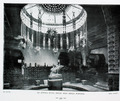Search
DONATE
Protagonists
Main Themes
Location
Financial/Statistical Data
Featured Works
Key Events
The Hungarian Pavilion
Eleonora Raspi
The Pavilion's Interior

The design and details of the Pavilion of Hungary introduced the world of Hun mythology and Hungarian traditions to European audiences, as had happened before at the International Arts and Crafts Exhibition in Venice (1909). The Spartan style of the exterior creates an effective contrast with the rich and harmonious ornamentation of the interior, combining the elements of military prowess with those of reverential faith for the Nation and its origins.
 The interior design of the Pavilion of Hungary gave a temple-like feel to the building. The stained glass windows filtered the light creating the sense of being in a sanctuary. In the Great Hall, visitors could admire the Fountain Court, in the middle of the room.
The interior design of the Pavilion of Hungary gave a temple-like feel to the building. The stained glass windows filtered the light creating the sense of being in a sanctuary. In the Great Hall, visitors could admire the Fountain Court, in the middle of the room.
The fountain, circular in shape and with decorated panels, recalled the Hercules Fountain of the Royal Palace (Visegrád) of King Mathias Covinus, considered the “father” of Hungarian national unity and culture. Both fountains occupy the middle of an enclosed, cloister-like space: in Visegrad, the fountain is the middle of the internal courtyard, and in Turin it was in the middle of the Hall of Honor.
The first hall in the Pavilion of Hungary was surmounted by a large dome: Light flooded from the dome’s perimeter hung two oversized folk ornaments. Dots, a familiar folk motive, covered the flat surfaces and the ceilings. Instead of moldings to mediate the connection between walls, the architects supplied a cornice covered with floral and abstract motifs. In addition they treat the upper parts of doorways with canted sides and flat arches, another ensemble motif on national style. Cabinets, ceramic objects from Zsolnay, and furniture displayed nationalistic folk motifs as well. The center of the hall featured an equestrian figure of the revered and mythic Attila (Alofsin 218).
The Pavilion of Hungary gave ample space to the two founding figures of Hungarian history and society: Attila and King Mathias Covinus. Both were essential points of reference for Hungarian national identity, and for the artistic and cultural development of the country. Choosing to name the Pavilion “Attila’s tent” was an act of homage to the Hungarian military tradition, and a less than subtle hint to Attila’s legendary martial prowess and ferocity. Attila, king of the Huns from 434 to 453 established his court in Eszetergom, a small town north of Budapest, and became a legendary figure, and the protagonist of numberless narratives, folk tales, theatrical pieces, and art works. When Mathias Covinus (1458-1490) became the king of Hungary, he presented himself as a second Attila. He commissioned an Italian poet, who was a guest at his court, to write the poem "Attila, flagello di Dio" in order to rehabilitate the legendary Hun chieftain, traditionally viewed as emblem of death, destruction, and violence. Covinus represented the humanist ideal of the sovereign, and his court became, for the first time in Hungarian history, one of the most prestigious centers of culture and art in Europe.
The Pavilion of Hungary had several features in common with the Hungarian pavilion built for the International Exposition in Milan in 1906. The 1906 Pavilion featured a large central hall with a circular fountain it its middle (the Duke’s fountain), which was more complex and larger than the fountain in the 1911 Pavilion. The decorations gracing the ceiling and the large circular windows were emulated, and multiplied in number, in the 1911 Pavilion.
The Art Nouvean elements, especially in the chandeliers, are similar to those that Bela Lajita realized for the “School in Vas Utza” in Budapest (1911-1912).
Work cited
Alofsin, Anthony. When Buildings Speak: Architecture as Language in the Hapsburg Empire and its Aftermaths 1867-1933. Chicago: U of Chicago P, 2006.
Cook, Jeffrey. Seeking structure from nature: the organic architecture of Hungary. Princeton: Princeton Architectural Press, 1996.
Imre, Kathy. Medgyaszay Istvan. Budapest: Akademia Kiad6, 1979. 33
Lechner, Odon, "A magyar formanyelv nem volt hanem lesz" in Muveszet (Budapest, June 1, 1906)
Macsai, John. “Architecture as Opposition”. Journal of Architectural Education (1984-). 38.4 (Summer 1985): 8-14.
Melani, Alfredo. “Some notes on the Turin International Exhibition”. The International Studio. XLIV, no 173. New York: John Lane Company, July 1911. 286-293
Éri, Gyongy and Jobbágyi, Zsuzsa. “The millennial celebrations of 1896”. A Golden Age: art and society in Hungary 1896-1914. Miami: Center for the Fine Art, 1989. 47-60.
Éri, Gyongy and Jobbágyi, Zsuzsa. A Golden Age: art and society in Hungary 1896-1914. Miami: Center for the Fine Art, 1989.
D. Fenyo, Mario. “Literature and political change: Budapest 1908-1918”. Transactions 77. Part. 6. Philadelphia: American Philosophical Society, 1987.
Frampton, Kenneth (Modern Architecture) 192-202.
Németh, L. “Art, Nationalism and Fin de Siecle.” Éri, Gyongy and Jobbágyi, Zsuzsa. A Golden Age: art and society in Hungary 1896-1914. Miami: Center for the Fine Art, 1989. 19-30.
Taft, Lorado. “Recent scalpture in various lands”. Modern tendencies in sculpture. The Scammon Lecture for the Art Institute of Chicago (1917). Chicago: University of Chicago, 1921.73-89.
Wallis, B.C. “The Peoples of Hungary: Their Work on the Land.” Geographical Review. Vol. 4, No. 6 (Dec., 1917). New York: American Geographical Society. 465-482
Wiebenson, Dora. The architecture of Historic Hungary. Media Film: Sonnenschein, "Sunshine," directed by Istavan Szabo (Hungary/Germany/Canada/Austria) 1999, 179 minutes. (National Championships)


